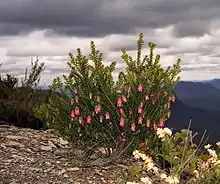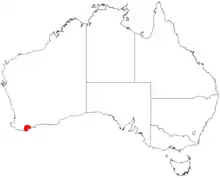Darwinia leiostyla
Darwinia leiostyla is an erect shrub in the family Myrtaceae and is endemic to the south-west of Western Australia. It typically grows to a height of 0.3–1.5 m (1 ft 0 in–4 ft 11 in) and has linear leaves up to about 10 mm (0.39 in) long crowded along the branches. Pendent, bell-shaped, flower-like inflorescences appear from May to January. These are clusters of small flowers surrounded by larger pink, red or white, petal-like bracts.[2][3]
| Darwinia leiostyla | |
|---|---|
 | |
| In the Stirling Range. | |
| Scientific classification | |
| Kingdom: | Plantae |
| Clade: | Tracheophytes |
| Clade: | Angiosperms |
| Clade: | Eudicots |
| Clade: | Rosids |
| Order: | Myrtales |
| Family: | Myrtaceae |
| Genus: | Darwinia |
| Species: | D. leiostyla |
| Binomial name | |
| Darwinia leiostyla | |
 | |
| Occurrence data from AVH | |
| Synonyms[1] | |
| |
Taxonomy
This species was first formally described in 1852 by Nikolai Turczaninow who gave it the name Genetyllis leiostyla in the Bulletin de la Classe Physico-Mathématique de l'Académie Impériale des Sciences de Saint-Pétersbourg.[4][5] In 1923, Karel Domin changed the name to Darwinia leiostyla in Vestnik Kralovske Ceske Spolecnosti Nauk, Trida Matematiko-Prirodevedecke.[6] The specific epithet (leiostyla) means "having a smooth style".[7]
Distribution and habitat
Darwinia leiostyla occurs in the Stirling Range and Middle Mount Barren on rocky sites, along streamlines and on slopes within gullies and ranges.[8]
Conservation status
Darwinia leiostyla is classified as "Priority Four" by the Government of Western Australia Department of Parks and Wildlife,[2] meaning that is rare or near threatened.[9]
Use in horticulture
This darwinia is sometimes grown as an ornamental plant. It requires a warm, dry situation and tip pruning to maintain its shape.[10] It is suitable for container growing or rock gardens.[3][10]
References
- "Darwinia leiostyla". Australian Plant Census. Retrieved 23 November 2020.
- "Darwinia leiostyla". FloraBase. Western Australian Government Department of Parks and Wildlife.
- Seale, Allan (1988). Garden Companion to Australian Native Plants. Australia: Reed Books. ISBN 0730101878.
- "Genetyllis leiostyla". APNI. Retrieved 24 November 2020.
- Turczaninow, Nikolai (1852). "Myrtaceae Xerocarpicae in Nova Hollandia a cl. Drummond lectae et plerumque in collectione ejus quinta distributae, determinatae et descriptae". Bulletin de la Classe Physico-Mathématique de l'Académie Impériale des Sciences de Saint-Pétersbourg. 10: 323. Retrieved 24 November 2020.
- "Darwinia leiostyla". APNI. Retrieved 24 November 2020.
- Francis Aubie Sharr (2019). Western Australian Plant Names and their Meanings. Kardinya, Western Australia: Four Gables Press. p. 237. ISBN 9780958034180.
- Gardner, C.A. (1981). Wildflowers of Western Australia. Perth: St George Books. p. 10. ISBN 086778007X.
- "Conservation codes for Western Australian Flora and Fauna" (PDF). Government of Western Australia Department of Parks and Wildlife. Retrieved 24 November 2020.
- Greig, D. (1987). The Australian Gardener's Wildflower Catalogue. Australia: Angus & Robertson. ISBN 0207154600.
| Wikimedia Commons has media related to Darwinia leiostyla. |
